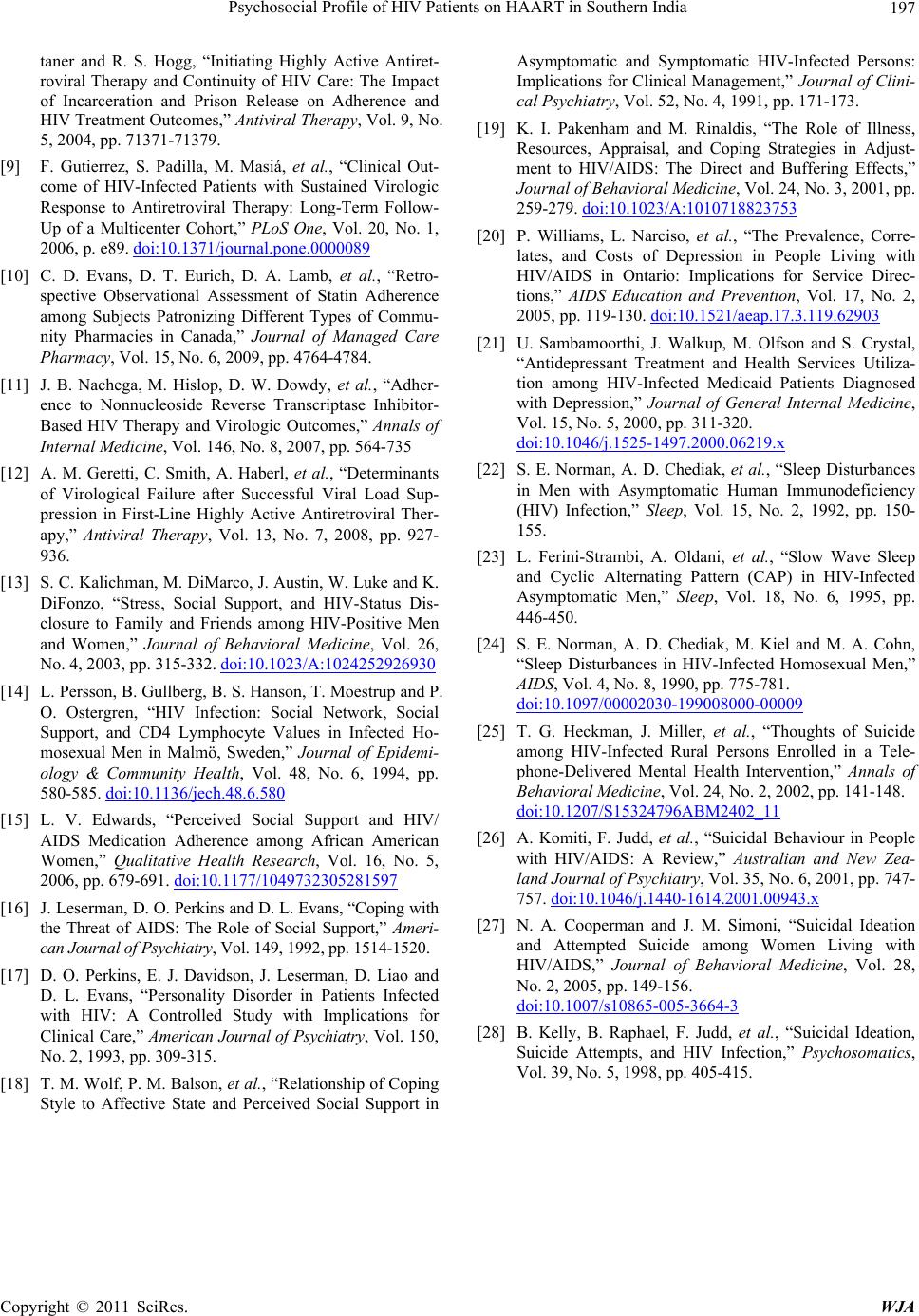
Psychosocial Profile of HIV Patients on HAART in Southern India197
taner and R. S. Hogg, “Initiating Highly Active Antiret-
roviral Therapy and Continuity of HIV Care: The Impact
of Incarceration and Prison Release on Adherence and
HIV Treatment Outcomes,” Antiviral Therapy, Vol. 9, No.
5, 2004, pp. 71371-71379.
[9] F. Gutierrez, S. Padilla, M. Masiá, et al., “Clinical Out-
come of HIV-Infected Patients with Sustained Virologic
Response to Antiretroviral Therapy: Long-Term Follow-
Up of a Multicenter Cohort,” PLoS One, Vol. 20, No. 1,
2006, p. e89. doi:10.1371/journal.pone.0000089
[10] C. D. Evans, D. T. Eurich, D. A. Lamb, et al., “Retro-
spective Observational Assessment of Statin Adherence
among Subjects Patronizing Different Types of Commu-
nity Pharmacies in Canada,” Journal of Managed Care
Pharmacy, Vol. 15, No. 6, 2009, pp. 4764-4784.
[11] J. B. Nachega, M. Hislop, D. W. Dowdy, et al., “Adher-
ence to Nonnucleoside Reverse Transcriptase Inhibitor-
Based HIV Therapy and Virologic Outcomes,” Annals of
Internal Medicine, Vol. 146, No. 8, 2007, pp. 564-735
[12] A. M. Geretti, C. Smith, A. Haberl, et al., “Determinants
of Virological Failure after Successful Viral Load Sup-
pression in First-Line Highly Active Antiretroviral Ther-
apy,” Antiviral Therapy, Vol. 13, No. 7, 2008, pp. 927-
936.
[13] S. C. Kalichman, M. DiMarco, J. Austin, W. Luke and K.
DiFonzo, “Stress, Social Support, and HIV-Status Dis-
closure to Family and Friends among HIV-Positive Men
and Women,” Journal of Behavioral Medicine, Vol. 26,
No. 4, 2003, pp. 315-332. doi:10.1023/A:1024252926930
[14] L. Persson, B. Gullberg, B. S. Hanson, T. Moestrup and P.
O. Ostergren, “HIV Infection: Social Network, Social
Support, and CD4 Lymphocyte Values in Infected Ho-
mosexual Men in Malmö, Sweden,” Journal of Epidemi-
ology & Community Health, Vol. 48, No. 6, 1994, pp.
580-585. doi:10.1136/jech.48.6.580
[15] L. V. Edwards, “Perceived Social Support and HIV/
AIDS Medication Adherence among African American
Women,” Qualitative Health Research, Vol. 16, No. 5,
2006, pp. 679-691. doi:10.1177/1049732305281597
[16] J. Le ser ma n, D. O. Perkins and D. L. Evans, “Coping with
the Threat of AIDS: The Role of Social Support,” Ameri-
can Journal of Psychiatry, Vol. 149, 1992, pp. 1514-1520.
[17] D. O. Perkins, E. J. Davidson, J. Leserman, D. Liao and
D. L. Evans, “Personality Disorder in Patients Infected
with HIV: A Controlled Study with Implications for
Clinical Care,” American Journal of Psychiatry, Vol. 150,
No. 2, 1993, pp. 309-315.
[18] T. M. Wolf, P. M. Balson, et al., “Relationship of Coping
Style to Affective State and Perceived Social Support in
Asymptomatic and Symptomatic HIV-Infected Persons:
Implications for Clinical Management,” Journal of Clini-
cal Psychiatry, Vol. 52, No. 4, 1991, pp. 171-173.
[19] K. I. Pakenham and M. Rinaldis, “The Role of Illness,
Resources, Appraisal, and Coping Strategies in Adjust-
ment to HIV/AIDS: The Direct and Buffering Effects,”
Journal of Behavioral Medicine, Vol. 24, No. 3, 2001, pp.
259-279. doi:10.1023/A:1010718823753
[20] P. Williams, L. Narciso, et al., “The Prevalence, Corre-
lates, and Costs of Depression in People Living with
HIV/AIDS in Ontario: Implications for Service Direc-
tions,” AIDS Education and Prevention, Vol. 17, No. 2,
2005, pp. 119-130. doi:10.1521/aeap.17.3.119.62903
[21] U. Sambamoorthi, J. Walkup, M. Olfson and S. Crystal,
“Antidepressant Treatment and Health Services Utiliza-
tion among HIV-Infected Medicaid Patients Diagnosed
with Depression,” Journal of General Internal Medicine,
Vol. 15, No. 5, 2000, pp. 311-320.
doi:10.1046/j.1525-1497.2000.06219.x
[22] S. E. Norman, A. D. Chediak, et al., “Sleep Disturbances
in Men with Asymptomatic Human Immunodeficiency
(HIV) Infection,” Sleep, Vol. 15, No. 2, 1992, pp. 150-
155.
[23] L. Ferini-Strambi, A. Oldani, et al., “Slow Wave Sleep
and Cyclic Alternating Pattern (CAP) in HIV-Infected
Asymptomatic Men,” Sleep, Vol. 18, No. 6, 1995, pp.
446-450.
[24] S. E. Norman, A. D. Chediak, M. Kiel and M. A. Cohn,
“Sleep Disturbances in HIV-Infected Homosexual Men,”
AIDS, Vol. 4, No. 8, 1990, pp. 775-781.
doi:10.1097/00002030-199008000-00009
[25] T. G. Heckman, J. Miller, et al., “Thoughts of Suicide
among HIV-Infected Rural Persons Enrolled in a Tele-
phone-Delivered Mental Health Intervention,” Annals of
Behavioral Medicine, Vol. 24, No. 2, 2002, pp. 141-148.
doi:10.1207/S15324796ABM2402_11
[26] A. Komiti, F. Judd, et al., “Suicidal Behaviour in People
with HIV/AIDS: A Review,” Australian and New Zea-
land Journal of Psychiatry, Vol. 35, No. 6, 2001, pp. 747-
757. doi:10.1046/j.1440-1614.2001.00943.x
[27] N. A. Cooperman and J. M. Simoni, “Suicidal Ideation
and Attempted Suicide among Women Living with
HIV/AIDS,” Journal of Behavioral Medicine, Vol. 28,
No. 2, 2005, pp. 149-156.
doi:10.1007/s10865-005-3664-3
[28] B. Kelly, B. Raphael, F. Judd, et al., “Suicidal Ideation,
Suicide Attempts, and HIV Infection,” Psychosomatics,
Vol. 39, No. 5, 1998, pp. 405-415.
Copyright © 2011 SciRes. WJA